Curiosity blooms early when little ones dig into hands-on exploration. This theme turns dirt, water, and sunlight into tools for teaching foundational concepts. Through playful activities, young minds discover how life grows—one seed at a time.
Imagine tiny hands pressing soil around a bean or sprinkling water on sprouts. These moments build motor skills while introducing basic biology. Outdoor play becomes a classroom where children observe roots, leaves, and petals up close. Even tossing a sunflower kernel into a pot sparks questions about nature’s magic.
Sensory experiences, like feeling textured leaves or smelling herbs, anchor learning in joy. Pairing these with group projects fosters teamwork—like creating a small-space gardening corner. Such tasks blend creativity with responsibility as kids care for their green friends daily.
Simple routines, such as tracking plant growth on a chart, teach patience and observation. Whether indoors or outside, every activity nurtures curiosity about the living world. Best of all? These ideas fit seamlessly into your existing curriculum for a lively, hands-on approach.
Understanding the Value of Gardening in Early Childhood Education
Young minds thrive when interacting with their environment. Outdoor activities create natural opportunities to explore textures, smells, and patterns. Imagine kids comparing smooth pebbles to bumpy pinecones or watching worms wriggle through damp soil. These moments spark questions about ecosystems while building critical thinking.
Connection Between Nature and Learning
Digging into garden beds teaches more than biology. Sorting seeds by size or color introduces early math concepts. Counting petals on flowers blends numeracy with outdoor play. When children chart a sprout’s growth each week, they grasp sequences and time measurement.
Developing Motor Skills and Sensory Awareness
Crumbling dry leaves strengthens finger muscles needed for writing. Pouring water into tiny pots hovers hand-eye coordination. Paper-based tasks, like tracing leaf shapes, extend learning indoors. Mixing these skills with messy play keeps lessons dynamic and inclusive.
Adapt tasks to match each child’s abilities. Some might plant sunflower seeds using tweezers, while others arrange pressed flowers on paper. This flexibility ensures every learner grows at their own pace through joyful exploration.
How to Introduce Garden Themes to Your Preschool Curriculum
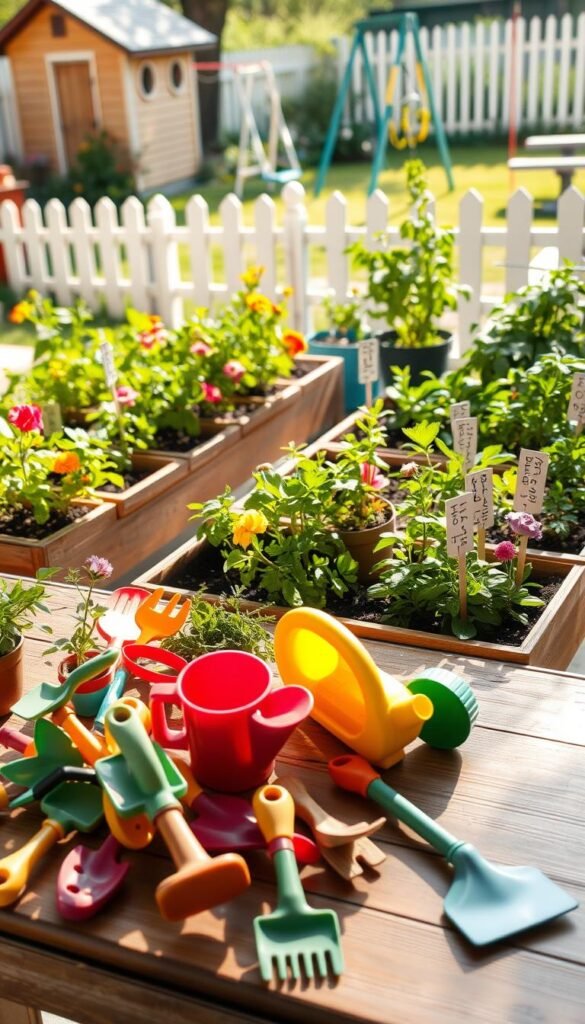
Transform your classroom into a vibrant learning space by weaving garden themes into daily routines. Start with themed corners featuring soil samples, seed packets, and kid-sized tools. Add magnifying glasses for inspecting leaves or insects, sparking natural curiosity through hands-on discovery.
Setting the Stage for Exploration
Create sensory bins filled with potting mix, dried beans, or smooth stones. Rotate materials weekly to maintain excitement—try adding fragrant herbs like mint or lavender. Use laminated plant life cycle charts as visual guides during group discussions. These setups encourage independent play while subtly reinforcing science concepts.
Using Simple Tools and Materials
Opt for lightweight, durable items like plastic trowels and spray bottles. Introduce colorful container gardening with recycled yogurt cups or shallow trays. This approach lets kids manage their mini-gardens easily. Pair tools with lesson plans that focus on repetition, like daily watering routines or measuring sprout growth.
Balance structured tasks with open-ended play. For example:
- Sort seeds by size before planting
- Create flower collages using pressed petals
- Role-play as gardeners tending to stuffed animal “pets”
These activities build responsibility while keeping the experience fun. Track progress with photo journals or simple growth charts—visible reminders of how care transforms tiny seeds into thriving greens.
Plants and Gardening Preschool Theme: Engaging Lesson Plans
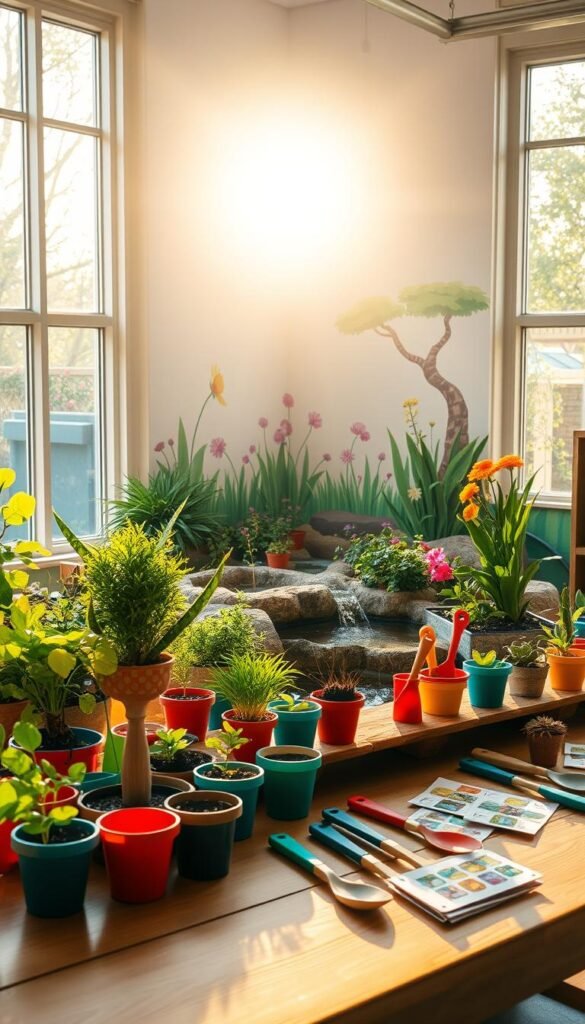
Turn everyday spaces into green classrooms with simple, structured steps. Start by designating a low-maintenance area for daily exploration—even a windowsill works. Focus on accessible tasks that let kids lead while building confidence.
Step-by-Step Plan to Implement the Theme
1. Organize Your Space: Use shallow trays or recycled containers for easy access. Label tools with pictures so children can grab watering cans or trowels independently. Keep soil in lidded bins to control mess.
2. Pick Fast-Growing Options: Choose flowers like marigolds or sunflowers for quick results. Herbs like basil add sensory appeal. Avoid fragile plants—opt for hardy varieties that bounce back from enthusiastic care.
3. Create Watering Routines: Assign specific days for hydration checks using colorful charts. Teach kids to test soil moisture with their fingers—crumbly means drink time! Use small spray bottles to prevent overwatering.
Adapt for tight spaces by stacking pots vertically or using hanging planters. For mixed-age groups, pair older kids with younger ones during planting tasks. Troubleshoot common issues:
- Yellow leaves? Too much water
- No sprouts? Check sunlight levels
- Mess concerns? Lay down washable mats
Rotate stations weekly to maintain excitement—swap seed sorting for flower pressing. Celebrate growth milestones with progress photos. This way, every child sees their impact on living things.
Hands-On Activities to Engage Little Gardeners
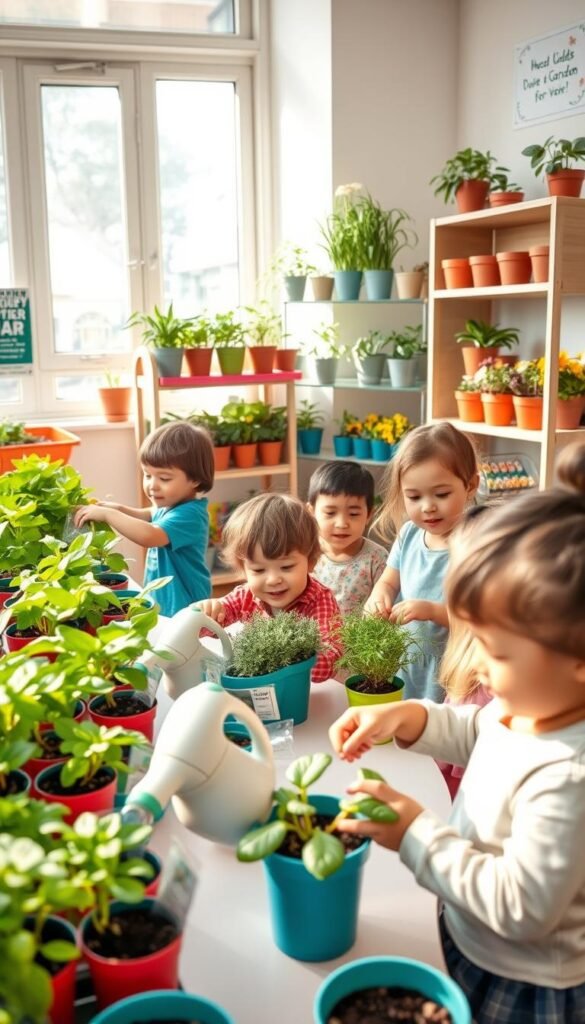
Tiny fingers squishing soil or sprinkling water—these moments turn simple materials into powerful learning tools. Discover how everyday items become tools for exploring life cycles and teamwork through projects that fit any space. Whether you’re working with limited resources or a sprawling outdoor area, these ideas blend play with purpose.
Planting Seeds and Container Gardening Ideas
Start with easy-to-handle seeds like beans or nasturtiums. Use recycled yogurt cups or egg cartons for container gardening basics. Kids love pressing seeds into soil and watching sprouts emerge. Track progress weekly with photos or height charts—this builds anticipation while teaching about growth timelines.
Try themed pots: paint faces on containers and let grass “hair” grow. Rotate planting stations to keep routines fresh. For tight spaces, hang vertical gardens using fabric pockets or repurposed shelves.
Interactive Experiments That Spark Curiosity
Turn science into play with simple tests. Place one pot in sunlight and another in shade—compare results over time. Add food coloring to water and watch stems drink up rainbow hues. Use magnifiers to inspect roots or insect visitors, sparking questions about ecosystems.
Create a “mystery seed” challenge: plant unlabeled varieties and guess what sprouts. Chart guesses vs. outcomes on a classroom board. These tasks sharpen observation skills while making science feel like detective work.
Set aside regular time for group projects, like building a mini greenhouse from plastic wrap and sticks. These shared efforts nurture responsibility and teamwork, proving even small hands can create big results.
Integrating Literacy, Math, and Science Through Garden Play
A garden becomes a classroom where letters, numbers, and hypotheses sprout naturally. By blending subjects through dirt-covered adventures, kids connect classroom concepts to real-world wonders. You’ll find endless ways to turn radishes into rulers and sunflower stalks into story starters.
Letters Meet Leaves: Literacy & Math Connections
Create alphabet scavenger hunts using vegetables with distinct shapes—like curly kale for “K” or oval okra for “O”. Count petals on flowers or sort seeds by size, building early math skills. For motor development, have kids trace letters in soil using sticks or arrange pebbles to spell plant names.
Set up a market stand with pretend price tags on produce. Children practice counting play coins while role-playing as gardeners. At home, families can extend learning by measuring herb growth weekly or reading stories about garden ecosystems.
Budding Scientists: Hands-On Experiments
Explore science basics by planting beans in clear cups to watch root development. Compare growth rates in sunlight vs. shade using simple charts. Ask questions like, “Why do stems bend toward windows?” to spark hypothesis-building.
Try rainbow celery experiments: place stalks in colored water to demonstrate capillary action. For art integration, make leaf rubbings or paint with natural dyes from crushed berries. These projects strengthen observation skills while teaching seasonal garden care basics.
Rotate activity stations every few days to maintain engagement. Combine tasks—like counting pumpkin seeds before planting them—to show how subjects interconnect. Through play, children discover that learning grows everywhere.
Outdoor and Sensory Experiences in the Garden
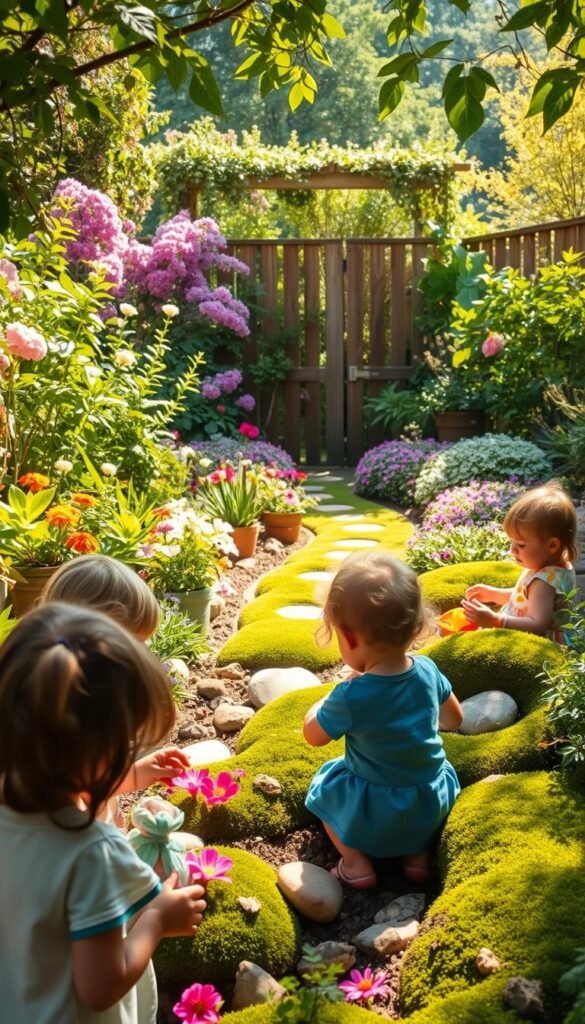
Sunlight filters through leaves as tiny explorers chart paths through grass and soil. These adventures transform ordinary yards into discovery zones where every rock and beetle tells a story. By blending movement with sensory engagement, you create ways to connect classroom concepts to real-world wonders.
Nature Walks and Insect Explorations
Turn strolls into learning games with scavenger hunts. Search for smooth stones, feathery ferns, or insects with striped patterns. Magnifying glasses become magic lenses for examining aphids on stems or ants marching in lines. Ask open-ended questions: “Why do pill bugs curl up?” or “How do worms help soil?”
Create picture cards showing common garden visitors—ladybugs, butterflies, earthworms. Kids match their finds to these visuals, sparking conversations about habitats. For tactile learners, set up texture stations with bark rubbings or mud painting. These ways of exploring deepen understanding of nature’s needs.
Balance free exploration with guided tasks. Use spray bottles for gentle watering practice—show how different plants have unique thirst levels. A wilted basil leaf becomes a lesson in care routines. Rotate stations weekly to maintain excitement while reinforcing core concepts through play.
Wrap sessions with group reflections: “What surprised you today?” or “Which bug would you study next time?” These moments cement discoveries while nurturing respect for living systems. Through joyful exploration, children grasp how every creature and plant fills vital roles.
Adapting Your Garden Lessons for Home and Classroom Settings
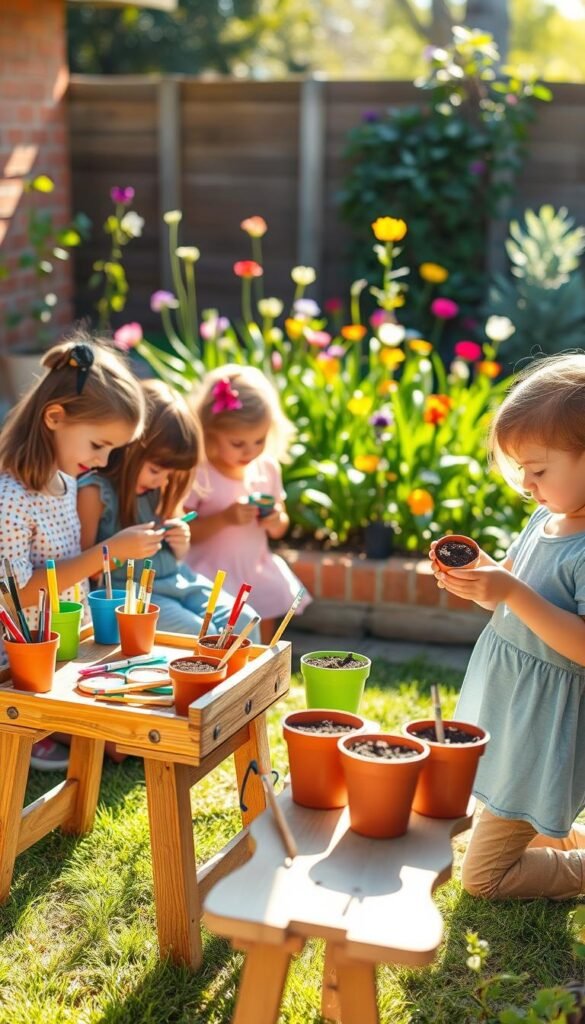
Learning sprouts everywhere when lessons bend to fit any space. Whether you’re working with a backyard or a corner of your living room, these ideas keep the magic of growth alive. Simple swaps let you maintain theme consistency while respecting different environments.
Quick DIY Projects and Play-Based Learning
Turn recycled items into tiny seed starters. Egg cartons become mini planters, while old spoons transform into measuring tools. Kids strengthen motor skills by scooping soil or threading yarn through punched holes in containers. These tasks adapt easily—use shoeboxes for home setups or shared trays in classrooms.
Try this table for activity adjustments:
| Location | Materials | Activity Example |
|---|---|---|
| Home | Recycled jars, kitchen herbs | Grow basil on windowsills |
| Classroom | Plastic bins, fast-sprouting seeds | Group sunflower races |
Play-based methods simplify complex ideas. Hide tiny seed packets in sensory bins for discovery games. Chart growth using hand-drawn rulers—counting leaves becomes math practice. Rotate stations weekly to match early childhood attention spans.
For tight spaces, hang vertical gardens using fabric pockets. Families can mirror classroom activities preschool with balcony herb boxes. Shared photo journals help preschoolers see connections between home and school projects.
Wrapping Up Your Gardening Journey with Memorable Projects
Sprouts of achievement deserve celebration as your garden unit blossoms to a close. Wrap up with creative ideas that blend play with reflection, letting kids showcase their discoveries. Try crafting nature journals where they sketch weekly growth or press colorful petals—perfect for revisiting lessons later.
Collaborative murals bring math into the mix. Have little learners count soil layers or sort seed packets by size. Add a seasonal twist by incorporating spring themes, like arranging tissue-paper blossoms on tree outlines. These projects solidify concepts while sparking pride in their green-thumbed efforts.
Pair hands-on tasks with storytelling. Share a garden-themed book during circle time, then discuss how characters cared for their plots. For playful science connections, try plant science activities like charting rainbow celery experiments or building recycled-material greenhouses. These final touches leave lasting impressions, nurturing both creativity and curiosity about the natural world.






